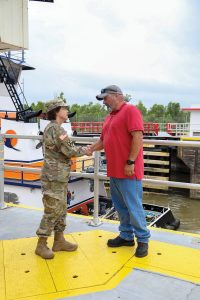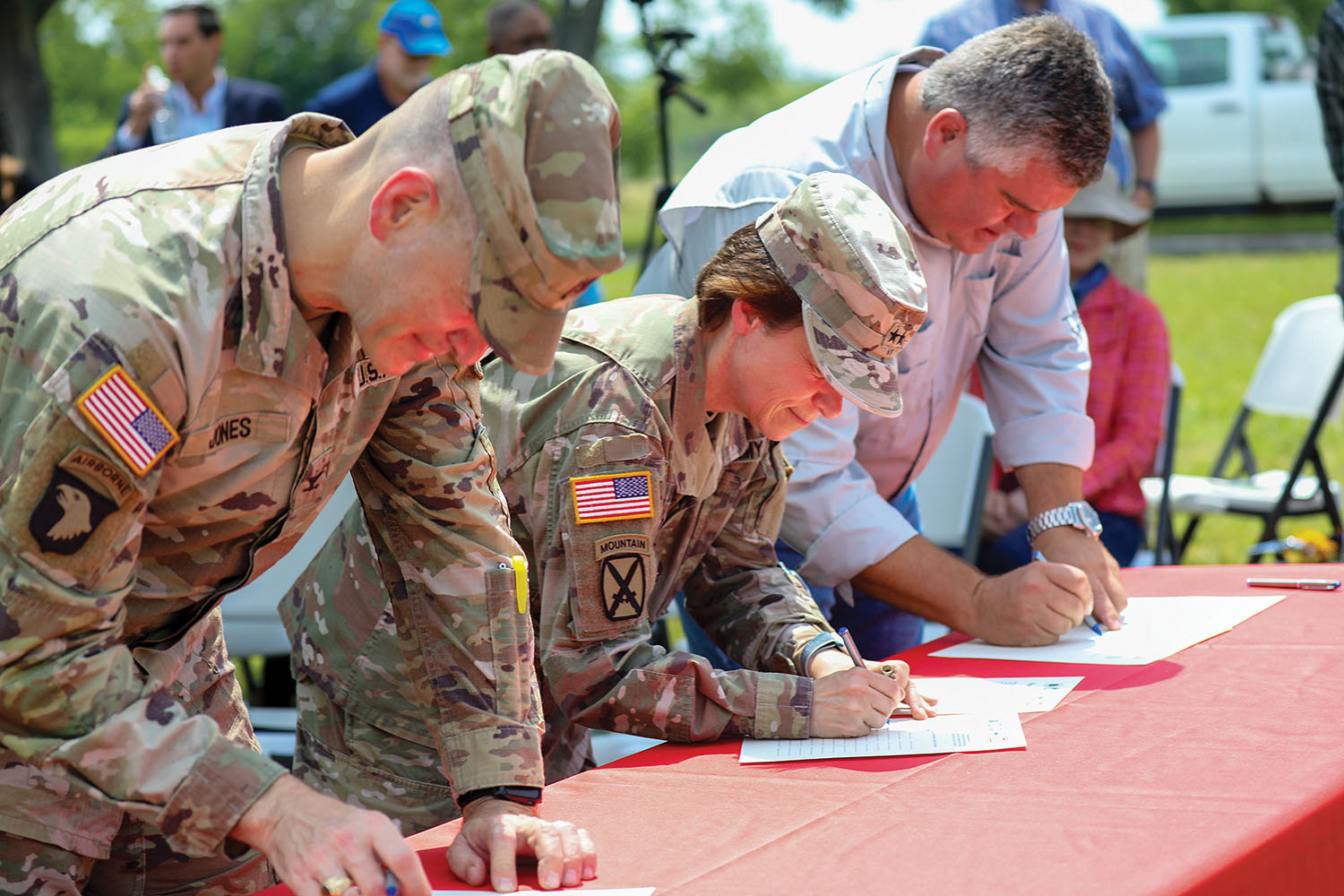Maj. Gen. Diana Holland, commander of the U.S. Army Corps of Engineers’ Mississippi Valley Division and president of the Mississippi River Commission, was in the New Orleans Engineer District in late June for her final inspection tour. Holland will transfer command of the Mississippi Valley Division to Brig. Gen. Kimberly Peeples, commander of the Great Lakes and Ohio River Division, on July 12.
During her tour, Holland joined Col. Cullen Jones, commander of the New Orleans District, and Ben Haase, the incoming executive director of Louisiana’s Coastal Protection and Restoration Authority (CPRA), at Calcasieu Lock on the Gulf Intracoastal Waterway to sign the project partnership agreement for the Southwest Coastal Louisiana risk reduction project.
The $6.5 billion project aims to provide both hurricane and storm damage risk reduction and coastal ecosystem restoration for a region of the state (Calcasieu, Cameron and Vermilion parishes) that was battered by a pair of powerful hurricanes in 2020 and serves as a base for much of the state’s oil and gas industry. The project was authorized in the Water Infrastructure Improvements for the Nation Act of 2016, with $286 million for the project included in the Bipartisan Infrastructure Law and $10 million in Community Project Funding appropriated in 2022 alone. Another $10 million will go toward the project’s first restoration component, which will include 6 miles of shoreline protection at Rockefeller Wildlife Refuge.
The nearly $300 million in funding will be used to elevate between 800 and 1,000 structures in the region as part of the project’s non-structural flood risk management plan. The project’s feasibility report identified a total of 3,462 residential structures eligible to be elevated. The project will carry a 65-35 cost-share ratio, with CPRA serving as the non-federal sponsor.
“We need to look no further back than hurricanes Laura and Delta to recall the devastation caused to these coastal communities here in Southwest Louisiana,” Holland said. “To deliver the nation’s commitment, USACE is applying a regional approach to delivery with the support of the Mississippi Valley Division and the Rock Island District.”
Jones highlighted the project’s multifaceted approach to reducing risk in the region.
“This partnering agreement is a first step in implementing the combined non-structural flood risk management and coastal restoration to deliver an overall 1 –percent level of risk reduction for the residents and businesses that participate in the program,” Jones said. “We look forward to working closely with CPRA and our local governments as we move forward to deliver risk reduction to this vital part of the nation.”
Of the more than 3,400 eligible structures, 27 have cleared the required assessments and are ready to be raised. The New Orleans District will host public meetings for area homeowners late this summer, with elevation work expected to begin in June 2024.
According to the Corps, residential structures will be raised, on average, five feet. Some 342 non-residential structures could be raised 3 feet above ground as part of the program, with 157 warehouses considered for a 6-foot berm construction.

“Today is a monumental day for our coastal program and the people of Southwest Louisiana,” CPRA Chairman Chip Kline said of the project partnership agreement. “With the signing of this agreement, the Corps will soon begin allocating nearly $300 million to elevate homes in Southwest Louisiana, reducing risk for the residents of Calcasieu, Cameron and Vermilion parishes. This huge step forward in the Southwest Coastal Louisiana project has been decades in the making and will positively impact the region for generations.”
“Today’s announcement is transformative for the people of Southwest Louisiana who have held strong in the face of some of the worst storms the country has ever seen,” Louisiana Gov. John Bel Edwards said in a statement. “The formalization of this partnership is a testament to the continued, shared commitment of the state and the Corps to work together to implement projects to help reduce flood risk and storm damage to the people and businesses living and working in the region.”
In addition to the structure raising component, the Southwest Coastal Louisiana project includes nine marsh restoration measures, two hydrologic and salinity control measures, five shoreline projection features, preservation of the Sabine Lake oyster reef, and reforestation of 1,400 acres within the Grand Chenier area.
While in the region, Holland, accompanied by a team from the New Orleans District, also visited the locks in the region along the Gulf Intracoastal Waterway. Following the tour, Holland posted a “thank you” to Jones and the New Orleans District for arranging her final tour of the district as the commanding general of the division. She also thanked the Louisiana National Guard’s aviation battalion “for providing the transportation, which was the only reason I was able to say ‘goodbye’ and ‘thank you’ to so many of our employees at these remote locations in one day. It was my last ride on an Army Black Hawk. It was a perfect day.”
Caption for top photo: From left, Col. Cullen Jones, Maj. Gen. Diana Holland, and Ben Haase sign partnership agreement. (Photo courtesy of Corps of Engineers)



